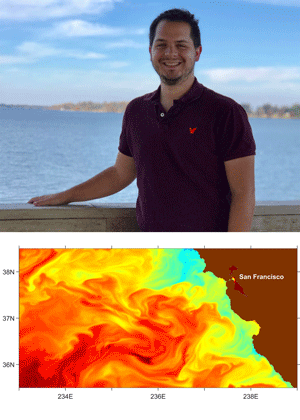By Joseph D’Addezio, oceanographer with the U.S. Naval Research Laboratory // NASA’s Stennis Space Center in southern Mississippi //
NASA’s S-MODE mission faces quite the challenge: robustly observe, for the first time, ocean features spanning up to about 6.2 miles (10 kilometers) across. Currently, the oceanographic community routinely observes and studies very large ocean features, primarily through space-based instrumentation. These include strong currents such as the Gulf Stream that runs from Florida along the East Coast of the United States all the way to western Europe. Large vortexes are also observed – these being the cyclones and anticyclones you may have seen on your evening weather forecasts.

On the other end of the size spectrum, we also understand quite a bit about much smaller ocean features such as surface waves you’ve seen every time you visit the beach. The features S-MODE is targeting are unique specifically because they are too small to be seen from space and too large and sparse to be sampled without having to commission a ship and an array of many other instruments.
So, S-MODE is on the hunt for these elusive features. Ocean models are one of the tools that S-MODE is utilizing. You may be aware that meteorologists are often aided by predictions provided by weather models. Fortunately for oceanographers, the same mathematical equations used by weather models can be used to predict the ocean. The Navy runs daily ocean models to estimate the current state of the global ocean and predict what the ocean may look like in several days. This ocean prediction capability is where the Navy and S-MODE intersect: ocean models provide another tool S-MODE can use to make targeted observations in its quest to find and understand kilometer-scale ocean features.
Running an ocean model is not easy. Firstly, the mathematical equations must be solved on a large three-dimensional grid using supercomputers. This requires many times more computation than what is available to the smart phone you may be reading this on. Secondly, the equations are extremely sensitive to the accuracy of the initial ocean state. Small errors in the initial estimate of the ocean increase exponentially with time. This problem is combated by routinely incorporating recent observations into the model to correct the errors the model is accumulating with time. This process is called data assimilation (yes, like the Borg aliens in Star Trek). This process is mostly science with a touch of art. I mean that decades of research have been poured into the subtleties of how to optimally blend the model prediction and the incomplete, but invaluable, observations we have of the ocean.
Ultimately, the ocean model is a useful but imperfect tool for the S-MODE mission. The model can’t tell S-MODE exactly where the kilometer-scale features of interest are, but it can give hints. A useful analogy might be tornado chasers. Operational weather models do not accurately predict exactly where a tornado will spawn. They do however tell astute users where favorable conditions exist for a tornado to form. The tornado chasers can then travel to an area of interest based on the model and use tools like radar (and at some point their eyeballs) to track a tornado. S-MODE employs a similar methodology. The ocean model will update using recent
observations and make a new prediction every day. The S-MODE team can monitor how the model expects the larger scale features of the region to evolve and move their ship to a region where features of interest might be expected to form.
About Joseph D’Addezio:
I work on research and development for the Navy’s ocean models, with a specific focus on data assimilation: the process by which the ocean model is updated to include information from recently taken observations. My group and I are stationed at NASA’s Stennis Space Center in southern Mississippi. Stennis is known primarily as a test site for NASA rocket engines. Sometimes the walls of the office shake. Most importantly, nothing beats New Orleans food. We could do without the hurricanes though.
